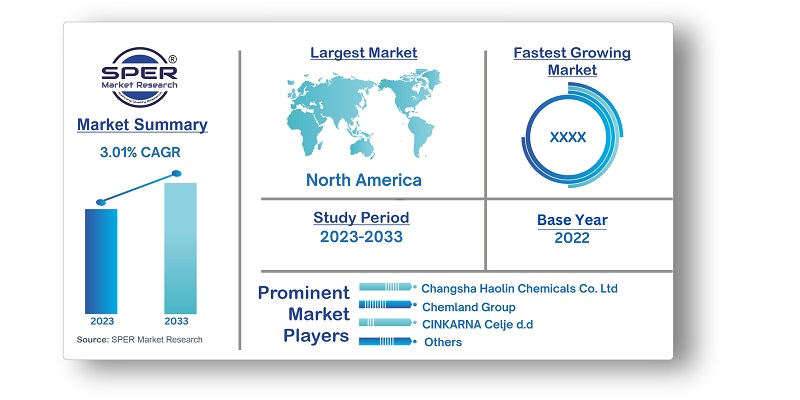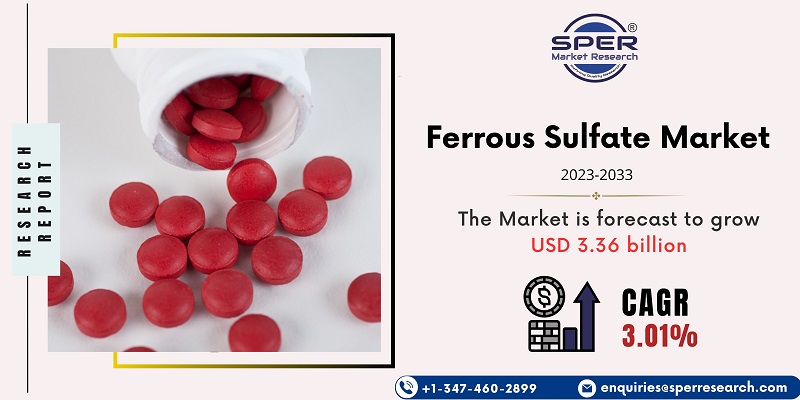
Ferrous Sulfate Market Trends, Growth, Size, Share, Revenue, Scope, Challenges and Future Outlook
Ferrous Sulfate Market Growth, Trends, Analysis, Size- By Product Type, By Application, By Form- Regional Outlook, Competitive Strategies and Segment Forecast to 2033
| Published: Nov-2023 | Report ID: CHEM23101 | Pages: 1 - 244 | Formats*: |
| Category : Chemical & Materials | |||
- In October, 2019: A new titanium dioxide (TiO2) pigment was introduced to the worldwide plastics market by Venator. Venator's best-performing white pigment for low-moisture applications and challenging processing circumstances is TIOXIDE TR29.
- In October, 2021: USALCO, a renowned manufacturer of superior industrial chemicals and water treatment products, reveals that it has purchased the water treatment division of ALTIVIA. In the United States, USALCO is a top supplier of premium specialty chemicals used in the treatment of water and wastewater as well as other industrial uses.


| Report Metric | Details |
| Market size available for years | 2019-2033 |
| Base year considered | 2022 |
| Forecast period | 2023-2033 |
| Segments covered | By Product Type, By End-Use, By Form |
| Regions covered | North America, Asia-Pacific, Latin America, Middle East & Africa and Europe |
| Companies Covered | Changsha Haolin Chemicals Co. Ltd., Chemland Group, CINKARNA Celje d.d., Coogee Chemicals Pty Ltd., Crown Technology Inc., Gökay Group, Hong Yield Chemical Industrial Co. Ltd., KRONOS Worldwide, Inc., PJSC Sumykhimprom, Rech Chemical Co. Ltd., Venator Materials PLC, Verdesian Life Sciences LLC, Others |
- Agricultural Industry
- Animal Feed Manufacturers
- Chemical Manufacturers
- Construction Industry
- Food and Beverage Industry
- Mining Industry
- Pharmaceutical and Nutritional Supplement Companies
- Water Treatment Companies
- Others
| By Product Type: | |
| By End-Use: | |
| By Form: | |
| By Region: |
- Global Ferrous Sulfate Market Size (FY’2023-FY’2033)
- Overview of Global Ferrous Sulfate Market
- Segmentation of Global Ferrous Sulfate Market By Product Type (Ferrous Sulfate Anhydrous, Ferrous Sulfate Heptahydrate, Ferrous Sulfate Monohydrate, Ferrous Sulfate Tetrahydrate, Others)
- Segmentation of Global Ferrous Sulfate Market By End-Use (Animal Feed, Construction, Pharmaceuticals, Pigments, Water Treatment, Others)
- Segmentation of Global Ferrous Sulfate Market By Form (Granule or Powder, Liquid, Others)
- Statistical Snap of Global Ferrous Sulfate Market
- Expansion Analysis of Global Ferrous Sulfate Market
- Problems and Obstacles in Global Ferrous Sulfate Market
- Competitive Landscape in the Global Ferrous Sulfate Market
- Impact of COVID-19 and Demonetization on Global Ferrous Sulfate Market
- Details on Current Investment in Global Ferrous Sulfate Market
- Competitive Analysis of Global Ferrous Sulfate Market
- Prominent Players in the Global Ferrous Sulfate Market
- SWOT Analysis of Global Ferrous Sulfate Market
- Global Ferrous Sulfate Market Future Outlook and Projections (FY’2023-FY’2033)
- Recommendations from Analyst
1.1. Scope of the report1.2. Market segment analysis
2.1. Research data source2.1.1. Secondary Data2.1.2. Primary Data2.1.3. SPER’s internal database2.1.4. Premium insight from KOL’s2.2. Market size estimation2.2.1. Top-down and Bottom-up approach2.3. Data triangulation
4.1. Driver, Restraint, Opportunity and Challenges analysis4.1.1. Drivers4.1.2. Restraints4.1.3. Opportunities4.1.4. Challenges4.2. COVID-19 Impacts of the Global Ferrous Sulfate Market
5.1. SWOT Analysis5.1.1. Strengths5.1.2. Weaknesses5.1.3. Opportunities5.1.4. Threats5.2. PESTEL Analysis5.2.1. Political Landscape5.2.2. Economic Landscape5.2.3. Social Landscape5.2.4. Technological Landscape5.2.5. Environmental Landscape5.2.6. Legal Landscape5.3. PORTER’s Five Forces5.3.1. Bargaining power of suppliers5.3.2. Bargaining power of buyers5.3.3. Threat of Substitute5.3.4. Threat of new entrant5.3.5. Competitive rivalry5.4. Heat Map Analysis
6.1. Global Ferrous Sulfate Market Manufacturing Base Distribution, Sales Area, Product Type6.2. Mergers & Acquisitions, Partnerships, Product Launch, and Collaboration in Global Ferrous Sulfate Market
7.1. Global Ferrous Sulfate Market Value Share and Forecast, By Product Type, 2023-20337.2. Ferrous Sulfate Anhydrous7.3. Ferrous Sulfate Heptahydrate7.4. Ferrous Sulfate Monohydrate7.5. Ferrous Sulfate Tetrahydrate7.6. Others
8.1. Global Ferrous Sulfate Market Value Share and Forecast, By End-Use, 2023-20338.2. Animal Feed8.3. Construction8.4. Pharmaceuticals8.5. Pigments8.6. Water Treatment8.7. Others
9.1. Global Ferrous Sulfate Market Value Share and Forecast, By Form, 2023-20339.2. Granule or Powder9.3. Liquid9.4. Others
10.1. Global Ferrous Sulfate Market Size and Market Share
11.1. Global Ferrous Sulfate Market Size and Market Share By Product Type (2019-2026)11.2. Global Ferrous Sulfate Market Size and Market Share By Product Type (2027-2033)
12.1. Global Ferrous Sulfate Market Size and Market Share By End-Use (2019-2026)12.2. Global Ferrous Sulfate Market Size and Market Share By End-Use (2027-2033)
13.1. Global Ferrous Sulfate Market Size and Market Share By Form (2019-2026)13.2. Global Ferrous Sulfate Market Size and Market Share By Form (2027-2033)
14.1. Global Ferrous Sulfate Market Size and Market Share By Region (2019-2026)14.2. Global Ferrous Sulfate Market Size and Market Share By Region (2027-2033)14.3. Asia-Pacific14.3.1. Australia14.3.2. China14.3.3. India14.3.4. Japan14.3.5. South Korea14.3.6. Rest of Asia-Pacific14.4. Europe14.4.1. France14.4.2. Germany14.4.3. Italy14.4.4. Spain14.4.5. United Kingdom14.4.6. Rest of Europe14.5. Middle East and Africa14.5.1. Kingdom of Saudi Arabia14.5.2. United Arab Emirates14.5.3. Rest of Middle East & Africa14.6. North America14.6.1. Canada14.6.2. Mexico14.6.3. United States14.7. Latin America14.7.1. Argentina14.7.2. Brazil14.7.3. Rest of Latin America
15.1. Changsha Haolin Chemicals Co. Ltd.15.1.1. Company details15.1.2. Financial outlook15.1.3. Product summary15.1.4. Recent developments15.2. Chemland Group15.2.1. Company details15.2.2. Financial outlook15.2.3. Product summary15.2.4. Recent developments15.3. CINKARNA Celje d.d.15.3.1. Company details15.3.2. Financial outlook15.3.3. Product summary15.3.4. Recent developments15.4. Coogee Chemicals Pty Ltd.15.4.1. Company details15.4.2. Financial outlook15.4.3. Product summary15.4.4. Recent developments15.5. Crown Technology Inc.15.5.1. Company details15.5.2. Financial outlook15.5.3. Product summary15.5.4. Recent developments15.6. Gökay Group15.6.1. Company details15.6.2. Financial outlook15.6.3. Product summary15.6.4. Recent developments15.7. Hong Yield Chemical Industrial Co. Ltd.15.7.1. Company details15.7.2. Financial outlook15.7.3. Product summary15.7.4. Recent developments15.8. KRONOS Worldwide, Inc.15.8.1. Company details15.8.2. Financial outlook15.8.3. Product summary15.8.4. Recent developments15.9. PJSC Sumykhimprom15.9.1. Company details15.9.2. Financial outlook15.9.3. Product summary15.9.4. Recent developments15.10. Rech Chemical Co. Ltd.15.10.1. Company details15.10.2. Financial outlook15.10.3. Product summary15.10.4. Recent developments15.11. Venator Materials PLC15.11.1. Company details15.11.2. Financial outlook15.11.3. Product summary15.11.4. Recent developments15.12. Verdesian Life Sciences LLC15.12.1. Company details15.12.2. Financial outlook15.12.3. Product summary15.12.4. Recent developments15.13. Others
SPER Market Research’s methodology uses great emphasis on primary research to ensure that the market intelligence insights are up to date, reliable and accurate. Primary interviews are done with players involved in each phase of a supply chain to analyze the market forecasting. The secondary research method is used to help you fully understand how the future markets and the spending patterns look likes.
The report is based on in-depth qualitative and quantitative analysis of the Product Market. The quantitative analysis involves the application of various projection and sampling techniques. The qualitative analysis involves primary interviews, surveys, and vendor briefings. The data gathered as a result of these processes are validated through experts opinion. Our research methodology entails an ideal mixture of primary and secondary initiatives.



Frequently Asked Questions About This Report
PLACE AN ORDER
Year End Discount
Sample Report
Pre-Purchase Inquiry
NEED CUSTOMIZATION?
Request CustomizationCALL OR EMAIL US
100% Secure Payment






Related Reports
Our Global Clients
Our data-driven insights have influenced the strategy of 200+ reputed companies across the globe.




















